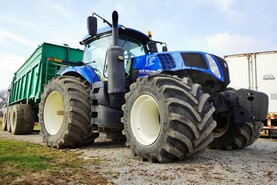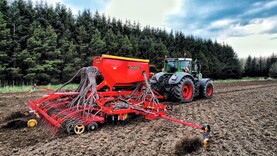Grass growth for the year to date has been strong, and for the most part daily growth rates have been running ahead of 2018 levels.
On the programme farms, monitoring weekly grass growth is part and parcel of good grazing management.
Walking the farm every week enables the farmers to identify when paddocks require fertiliser to be applied before a grazing shortage develops.
The same exercise allows the farmers to identify when a grass surplus is likely to materialise, allowing them to shut off paddocks and remove silage.
Measuring grass growth can be as simple, or as complex, as you make it. But whether grass covers are gauged by eye or plate meter, walking paddocks makes the farmers more aware of what actions are required each week to keep top-quality grazing swards in front of cattle.
Measuring
Five of the programme farms have measured grass on a weekly basis from the beginning of May to mid-July and grass yields are outlined in Table 1.
Grass growth has averaged 4.64t DM/ha over a 75-day period from 1 May, a 16% increase on 2018 and 2% increase on 2017 yields.
On the individual farms, the two highest yielding farms were located in Co Tyrone.
Soil type and moisture levels will most likely have had an impact on growth rates, as both farms operate on heavier soils. Soil moisture will have sustained grass growth during dry periods in May.
Grass yields
Oliver McKenna farms at Eskra and from May to mid-July, grass yields averaged 5.32t DM/ha, an increase of 10% on last year and a 38% increase in yield on 2017.
Grass is measured weekly on an 11.7ha grazing block. Current stocking rates mean that this land block is required to grow 56.2kg DM/ha every day to meet livestock demand.
Grass growth has averaged 71kg DM/ha/day from May to July, meaning that grass growth has exceeded demand and a surplus of grass will have accumulated which which provides additional winter fodder.
Growth accelerated to peak levels during early June. At the start of May, daily growth rates on farm were typically 60kg DM/ha/day. This increased to 100kg DM/ha/day by early June, with peak growth rates hitting 132kg DM/ha/day midway through the month. In contrast, during 2018, peak grass growth was recorded at 140kg DM/ha/day in mid May.
Paddock performance
Declan Rafferty and Aidan Quinn recorded the highest grass growth from May to July, with yields of 5.56t DM/ha.
On the grazing block where grass is recorded, the top-performing paddock yielded 12.3t DM/ha, with the worst performing paddock yielding 2.2t DM/ha.
Both paddocks are located on the same land block, which has been reseeded within the past five years.
However, soil type, paddock location and management have affected grass growth. The best-performing paddock is free-draining, allowing surface water to drain off quickly.
The worst performing paddock is low- lying and has heavy clay soils with very little natural drainage to remove surface water.
The same paddock was partially damaged from grazing during wet weather in early spring. As a result, soils are mostly likely suffering from compaction issues, which is negatively reflecting on grass growth.
Dry land
Grass growth on Thomas and Paul Jamison’s farm averaged 3.62t DM/ha from May to July. Although yields are lower than the other farms recording grass growth weekly, the farm operates on drier land.
Lower soil moisture levels will have hindered grass growth during prolonged dry spells in May, compared to the other farms.
However, grass yields on farm are significantly higher when compared to 2018, when the effects of drought severely curtailed grass growth during the summer.
Grass growth did exceed livestock demand on the grazing block this year. During May, sward covers were building and getting ahead of cattle.
Therefore, to bring swards back under control, surplus grass was removed as baled silage in mid-May.
Rotation length
Grass growth naturally starts to slow during July before increasing again in August. As grass growth slows, farms can quickly run into a grazing deficit as livestock demand exceeds growth rates.
Walking swards weekly can prevent this from occurring, especially where animals are grazing in a defined rotation.
Ideally, the grazing rotation in mid-July should be 18 to 20 days, to ensure cattle are going into paddocks at optimum sward heights of 10cm to 15cm.
But as grass growth slows, grazing rotations will be extended to around 20 to 22 days ahead of cattle, to avoid a grazing deficit.
Rotations can be extended through more frequent fertiliser applications, and by bringing silage ground into the grazing block.
Read more
Fodder alternatives for the coming winter
Mercosur legal text must protect Irish and European farmers – Creed
Grass growth for the year to date has been strong, and for the most part daily growth rates have been running ahead of 2018 levels.
On the programme farms, monitoring weekly grass growth is part and parcel of good grazing management.
Walking the farm every week enables the farmers to identify when paddocks require fertiliser to be applied before a grazing shortage develops.
The same exercise allows the farmers to identify when a grass surplus is likely to materialise, allowing them to shut off paddocks and remove silage.
Measuring grass growth can be as simple, or as complex, as you make it. But whether grass covers are gauged by eye or plate meter, walking paddocks makes the farmers more aware of what actions are required each week to keep top-quality grazing swards in front of cattle.
Measuring
Five of the programme farms have measured grass on a weekly basis from the beginning of May to mid-July and grass yields are outlined in Table 1.
Grass growth has averaged 4.64t DM/ha over a 75-day period from 1 May, a 16% increase on 2018 and 2% increase on 2017 yields.
On the individual farms, the two highest yielding farms were located in Co Tyrone.
Soil type and moisture levels will most likely have had an impact on growth rates, as both farms operate on heavier soils. Soil moisture will have sustained grass growth during dry periods in May.
Grass yields
Oliver McKenna farms at Eskra and from May to mid-July, grass yields averaged 5.32t DM/ha, an increase of 10% on last year and a 38% increase in yield on 2017.
Grass is measured weekly on an 11.7ha grazing block. Current stocking rates mean that this land block is required to grow 56.2kg DM/ha every day to meet livestock demand.
Grass growth has averaged 71kg DM/ha/day from May to July, meaning that grass growth has exceeded demand and a surplus of grass will have accumulated which which provides additional winter fodder.
Growth accelerated to peak levels during early June. At the start of May, daily growth rates on farm were typically 60kg DM/ha/day. This increased to 100kg DM/ha/day by early June, with peak growth rates hitting 132kg DM/ha/day midway through the month. In contrast, during 2018, peak grass growth was recorded at 140kg DM/ha/day in mid May.
Paddock performance
Declan Rafferty and Aidan Quinn recorded the highest grass growth from May to July, with yields of 5.56t DM/ha.
On the grazing block where grass is recorded, the top-performing paddock yielded 12.3t DM/ha, with the worst performing paddock yielding 2.2t DM/ha.
Both paddocks are located on the same land block, which has been reseeded within the past five years.
However, soil type, paddock location and management have affected grass growth. The best-performing paddock is free-draining, allowing surface water to drain off quickly.
The worst performing paddock is low- lying and has heavy clay soils with very little natural drainage to remove surface water.
The same paddock was partially damaged from grazing during wet weather in early spring. As a result, soils are mostly likely suffering from compaction issues, which is negatively reflecting on grass growth.
Dry land
Grass growth on Thomas and Paul Jamison’s farm averaged 3.62t DM/ha from May to July. Although yields are lower than the other farms recording grass growth weekly, the farm operates on drier land.
Lower soil moisture levels will have hindered grass growth during prolonged dry spells in May, compared to the other farms.
However, grass yields on farm are significantly higher when compared to 2018, when the effects of drought severely curtailed grass growth during the summer.
Grass growth did exceed livestock demand on the grazing block this year. During May, sward covers were building and getting ahead of cattle.
Therefore, to bring swards back under control, surplus grass was removed as baled silage in mid-May.
Rotation length
Grass growth naturally starts to slow during July before increasing again in August. As grass growth slows, farms can quickly run into a grazing deficit as livestock demand exceeds growth rates.
Walking swards weekly can prevent this from occurring, especially where animals are grazing in a defined rotation.
Ideally, the grazing rotation in mid-July should be 18 to 20 days, to ensure cattle are going into paddocks at optimum sward heights of 10cm to 15cm.
But as grass growth slows, grazing rotations will be extended to around 20 to 22 days ahead of cattle, to avoid a grazing deficit.
Rotations can be extended through more frequent fertiliser applications, and by bringing silage ground into the grazing block.
Read more
Fodder alternatives for the coming winter
Mercosur legal text must protect Irish and European farmers – Creed






 This is a subscriber-only article
This is a subscriber-only article










SHARING OPTIONS: